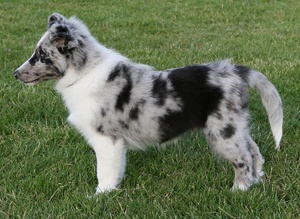“This post contains affiliate links, and I will be compensated if you make a purchase after clicking on my links.”
Description
The Shetland Sheepdog, also called as Sheltie, is a popular breed of dog that originated in Scotland. The breed belongs to the Herding family which is notable for their ability to control the movement of other animals. Shelties are bred for the purpose of herding. They usually come in small to medium sizes. Their straight double coat is long, though rather short and tight underneath. It typically comes in various colors such as blue merle, sable, and black with some white or tan markings.
Height and Weight
Both the male and female members of the Shetland Sheepdog breed share a common height of about 13 to 16 in measured at the withers. They also usually have the same approximate weight, that is, 20 lbs.
Temperament

Shelties are loyal, willing to obey, and eager to please. Considered to be one of the brightest breeds, this herding dog is lively and highly trainable. They are very intelligent in that they need to be kept busy. The breed is also a very intelligent herder. As a matter of fact, they can hold a little sheep in check as much as it could command large cattle. Shelties are alert and docile with pleasant temperament. They enjoy chasing things. The breed also makes wonderful companions. They are loving and affectionate toward their family, though can be rather suspicious with strangers. Socializing them well at an early age is necessary. Shelties make good watchdogs. They are quite sensitive to the owner’s tone of voice; making harsh punishments unnecessary. They require masters who are calm but firm leaders.
Grooming
Brushing Sheltie’s long double coat on a regular basis is necessary. Doing so a couple of times a week is important. Owners can bathe or dry shampoo the pet only when very necessary. They are seasonally medium to heavy shedders.
Health Concerns
Shelties have an average lifespan of 12 to 15 years. Some of the common health issues known to plague them include luxating patella, canine hypothyroidism, canine epilepsy, seizures, eye problems, heart diseases, hip dysplasia, and von Willebard disease.
Best Environment
Members of the Sheltie breed generally do well in a calm household environment. They need a safe place where they can play and thrive. A secure dwelling with a yard that lets them run without a leash can make them happy. Apartment-living can be good, too, provided that they receive sufficient exercise. Because they are a very active breed, plenty of exercise is very necessary. Taking them on a walk or jog every day is important.














